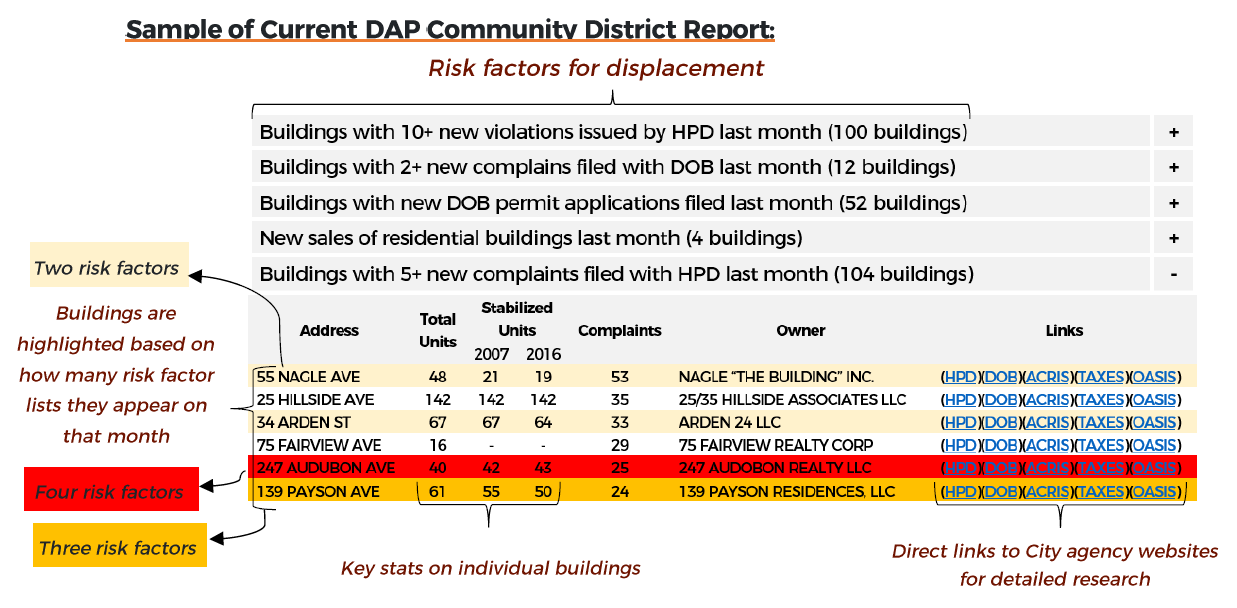Displacement Alert Project Map Gives Activists and Policy Makers Key Information to Proactively Address the Displacement Crisis
The tenant displacement crisis is at the center of neighborhood concerns and City policy focus. We cannot allow market forces to price and push out our City’s diverse communities. ANHD today released the Displacement Alert Project Map (the DAP Map) that, for the first time, presents key information in an interactive, easy-to-use map that local activists, service providers and policy makers have long needed.
www.dapmapnyc.org
The DAP Map is a web-based, building-by-building map designed to show where residential tenants may be facing significant displacement pressures across New York City. Read the exclusive report about the DAP Map in this piece published today in the New York Times – New Tool Shows New York Neighborhoods At Risk Of Rent Hikes
The DAP Map has three data view options and one combined risk score view. Each view option is based on unique data compiled by ANHD. The map shows previously unavailable building-level data, and color-codes buildings by risk-level so the information is clear and intuitive:
- Is there a high rate of loss of rent-regulated tenants in the building?
- Do NYC Department of Buildings permits indicate a high rate of tenant turnover?
- Was the building sold for a price that might indicate a speculative investment strategy?
- Where do we see building facing multiple combined risks?
Clicking on any individual building and details about that particular risk in that building appears in a pop up box. The DAP Map can also be searched by entering an individual building address.
ANHD developed the DAP Map as a strategic tool for tenants, community groups, service providers and policy makers who want to address NYC’s displacement crisis. Our ANHD neighborhood groups know that growing market pressures are impacting existing affordable housing, and increasing tenant harassment and displacement in many neighborhoods. The DAP Map can be used to:
- Identify at-risk buildings.
- Provide proactive outreach and education tenants.
- Identify where and why neighborhoods might be experiencing a wave of displacement pressure.
- Align government policies on displacement to real-time displacement forces and trends.
The DAP Map data is currently viewable only at an individual building level – aggregate data will be included in the next phase of the project. Meanwhile, ANHD analyzed the aggregate level data and found the following neighborhood patterns:
- There are 96,000 multi-family buildings in the data set. They all had at least one indicator of potential displacement concern: sold in 2015, at least one rent regulated unit since 2007, or had a residential DOB since 2013.
- New York City has lost over 156,000 rent-regulated units from 2007 to 2014.
- Nearly 26% of the buildings on the DAP Map have a high risk score, suggesting increasing rents.
- In over 5,400 buildings, the 2015 sales price per unit increased by more than double the 2010 area average.
- Just 10 zip codes account for one-quarter of all the buildings in NYC that lost a high percentage of rent regulated units between 2007 and 2014.
- Twenty-five zip codes account for one-half of all the NYC buildings that lost a high percentage of their rent regulated units in that same time period.
- In those same 25 zip codes, there is a correspondingly high number of Department of Buildings permits, with 16 of these zip codes showing exceptionally high DOB permit activity.
- In those same 25 zip codes, there is a correspondingly high number of exceptionally high per-unit property sale prices. In 12 of those zip codes, the average per-unit sale price was 150% above the average price in the surrounding area.
New York’s low-income communities, communities of color, and immigrant communities have been disproportionately impacted segregation, redlining, and predatory practices, and are increasingly feeling pushed out of our City. ANHD and our members are committed to stopping New York City’s growing displacement crisis and building a more equitable future for all of our City’s neighborhoods.
The DAP Map can be a tool to uncover problem buildings and patterns that City policy can help to address. This past spring, Mayor de Blasio committed to enacting a new, city-wide Certificate of No Harassment program as one key tool to help prevent displacement and preserve affordable housing.
 ANHD 2016 Building the Community Development Movement
ANHD 2016 Building the Community Development Movement

